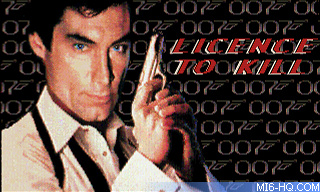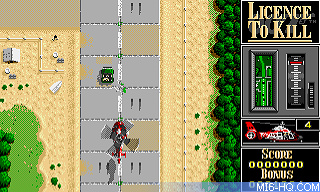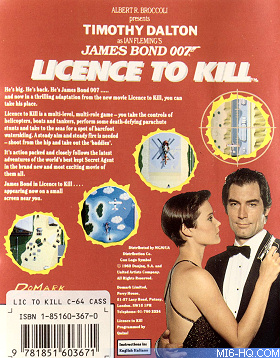 |
| |
Two of the original developers of the movie tie-in title reflect on producing the 1989 computer game...
|
|
Making The Licence To Kill Game
12th December 2011
Two months before the film opened, the computer
game adaptation of "Licence
To Kill"
hit store shelves in April 1989 for IBM PC,
Amiga 500/600,
Commodore C64/128,
Spectrum 48K,
Amstrad CPC,
Atari 8-bit and
Atari ST. In terms of platform support, it still remains one
of the widest released 007 titles ever.
|
Chris West - Programmer
Can you give the readers a bit of insight as to how License
to Kill was created?
"Licence to Kill" was developed by a company called Quixel. The development
team consisted of Tony (my twin brother and the graphics artist), myself and
two chaps from Domark. It was a six month project from start to finish and great
fun all the way. We had early scripts to work from and slides of some of the
scenes they had shot up to then. At the time we started work, they had only filmed
the opening sequence, hence most of the game is based around that part. We got
invited to Pinewood a couple of times to watch early versions of the film and
met Mr. Broccoli there. The game took virtually 10 hours a day every day for
the six months to do with four coders each - one for each platform and
Tony doing all the graphics. A little known fact is that the Amstrad and Spectrum
versions were actually written by Raph Cecco. We even managed to get License
to kill done ahead of schedule. |
|

|
What happened to the unreleased NES version of Licence to Kill?
There was a NES version being written by Simon Nicol who created Mega Apocalypse
on the Commodore 64. Among others, I remember going down to see him in Brighton
after we had finished all the other versions of "Licence to Kill" with
all the graphics and stuff.
|


|
|
He had most of the game done; he was just missing the
last level at that time. I believe it was finished but
Domark didn’t think it was worth releasing because
it was finished quite a time after the release of the film
and in those days you had to pay a lot of money up front
before Nintendo would make the cartridges. So Domark abandoned
it.
Are you still in the video games industry?
We’re still coding away, been doing this for about 20 years now for various
companies - Domark, DI, Virgin, Ubisoft and Empire.
How creative did one have to be to design
the levels for "Licence
to Kill"?
It was a challenge when we only had the script to work with, but once we saw
some slides we pretty much knew what we wanted to do, the last level was done
in a day if I remember rightly. After we saw the film, we felt we needed to
add the tankers in. |
When the game came out, what did the general public think of
it?
It got average reviews. It was said to be the best Bond game
to date so that was good. It got between 60% and 85% in most
magazines - wasn’t stunning but wasn’t rubbish
either.
|
Paul Margave - Programmer
What was the highlight of working on the game?
For "Licence to Kill" we got to go along to the preview of the film
at Pinewood Studios. We saw the final cut of the film, some scenes and the
music was missing. I even saw Mr. Broccoli there as well.
How enjoyable was your experience when you were creating
Bond games?
It was quite a laugh really; we were based in a small office out in Ottershaw,
Surrey. We had a pub over the road - it used to get fights in it sometimes,
but not us. Everyone who worked there was really down to earth.
It could get
stressful toward the end, bug finding, late nights... 24 hour shifts were
not unheard of. We were always rushing to finish them,
in those days you tried
to have the game finished within six months. |
|

|
What were some more challenging parts of coding the James Bond
games?
Memory in those days was tight, all those platforms had meager amounts compared
with today’s consoles, the entire game, graphics and sound would have to
fit in the space of one ‘texture’ in today’s games.
Thanks to 'Lethal Weapon'